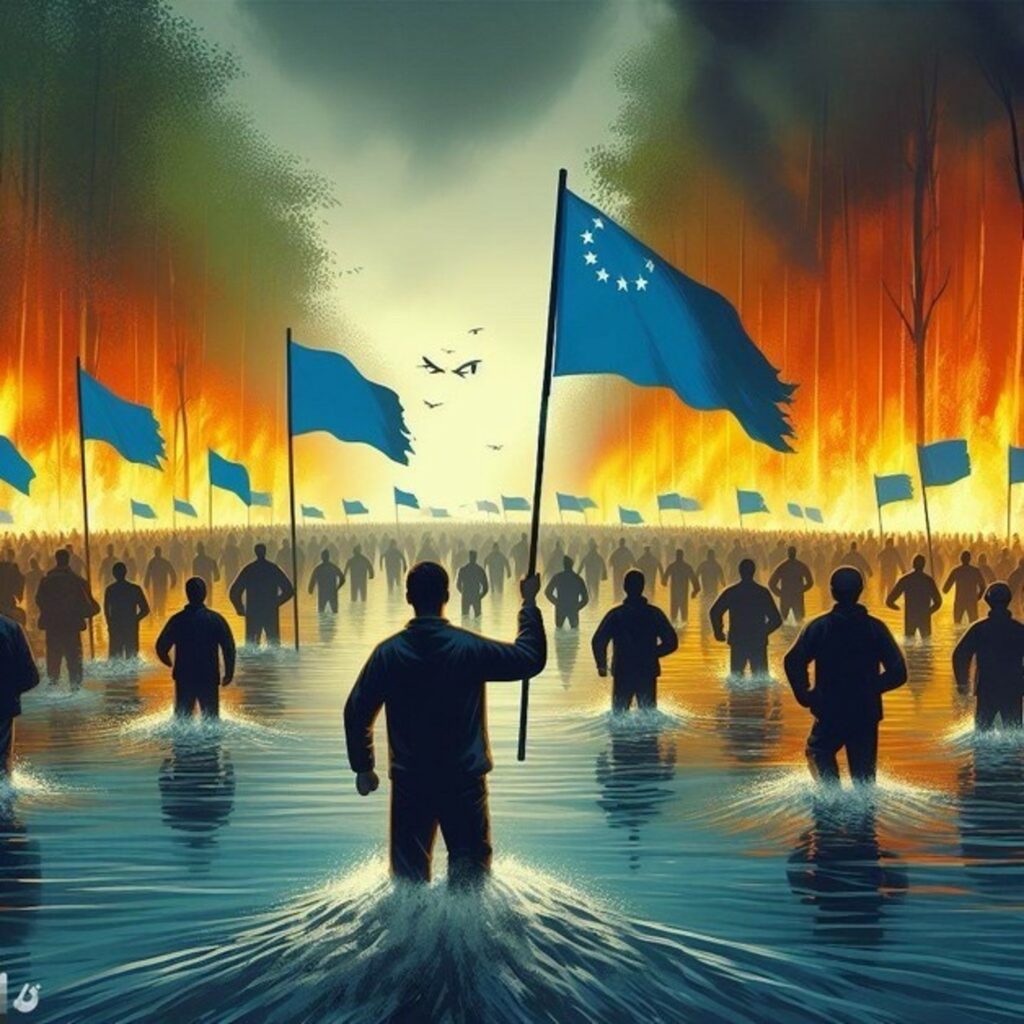A Crescendo in Hydro-Forecasting: Moving Beyond Incremental Gains
By Florian Pappenberger
As I sit in a beach house, the wind screams like a banshee, and rain assaults the windows like a barrage of rogue pebbles. The ocean outside is a tumultuous grey, its waves battering the sand with relentless fury. Small figures, armored against the elements, make their way along the shore, heads bowed in the face of the storm. This wild yet oddly tranquil scene has led me to contemplate a different kind of tempest – the one stirring within the realm of (hydrological) forecasting. This isn’t a storm of inclement weather, but rather a once-quiet revolution that has found its voice.
I recall the paper by Bauer and colleagues on the quiet revolution of numerical weather predictions. This work depicted a journey of steady advancement, with skill improving incrementally over decades (one day of lead time a decade on average – today’s one-week forecasts are about as good as a typical three-day forecast was in the 80s). Flood forecasts advanced even faster. Models, which were once cumbersome machines spewing out a spaghetti of uncertainty, have evolved into streamlined devices producing detailed forecasts with remarkable precision. This transformation is a tribute to the relentless dedication of our scientific predecessors, a gradual ascent towards taming the unpredictable moods of Mother Nature.
However, this “quiet revolution” has always seemed a bit too… silent. Don’t misunderstand me; I’m not disputing the progress made. Each percentage point shaved off a forecast error equates to lives saved and infrastructure preserved from the wrath of nature. Even small improvements can have significant real-world implications for decision-making in various sectors like agriculture, aviation, and disaster preparedness. Yet, I yearn for more rapid advancements. Is this the best we can achieve?
Here are some key reasons why it matters:
Urgency of climate change: The increasing intensity and frequency of extreme weather events due to climate change heighten the need for more precise and long-range forecasts. Slow improvements might not be enough to effectively prepare for and mitigate the impact of these events.
Societal and economic impact: Inaccurate or delayed forecasts can have significant economic consequences for sectors like agriculture, transportation, and energy. For example, farmers rely on accurate weather predictions to make crucial planting and harvesting decisions, while airlines use them to optimize flight routes and minimize delays.
Public safety concerns: Early and accurate warnings of severe weather events like floods, hurricanes, and heatwaves are crucial for protecting lives and property. Slow progress in forecasting these events can leave communities vulnerable and unprepared.
Technological advancements: Rapid advancements in other fields like artificial intelligence and supercomputing raise expectations for similar leaps in weather forecasting. The slow pace of progress might be perceived as a missed opportunity to leverage these technologies for greater accuracy.
Additionally, the slow pace of progress can have other implications
- Undermining confidence in science: Public perception of slow progress in weather forecasting could spill over to broader skepticism towards scientific research and its potential to address critical challenges.
- Stifling innovation and investment: The perception of slow progress might discourage further investment in research and development, hindering the potential for breakthrough technologies and solutions.
It’s time for us to confront some challenging questions:
- Are we trapped in a paradigm rut, adhering to obsolete methods due to habit or fear of exploring the unknown?
- Have we become so focused on the how of forecasting that we’ve forgotten the why?
- What forecast skill improvement rate is really relevant for impact, politics and decision making?
- Do we actually know what questions to ask or are we just able to write 42 approaches down (disguised as questions)?
I don’t claim to have all the answers, nor am I suggesting a complete overhaul of our current methods. The quiet revolution paper serves as a valuable reminder of the strides we’ve made and the robust foundation we’ve established. However, we mustn’t confuse this foundation for the completed structure.
We possess the tools, the talent, and the data – what we need now is the audacity to dream bigger, to push the boundaries, and to ignite the quiet revolution within us. Perhaps I’m just impatient, eagerly awaiting the day we can predict a flash flood with the same certainty as tomorrow’s sunrise.
Reading
- Peter Bauer’s Nature paper: “The quiet revolution of numerical weather prediction” (https://www.nature.com/articles/nature14956) This paper forms the core basis for this article.
- World Meteorological Organization (WMO) Hydrological Programme (https://community.wmo.int/en/about-hydrology-and-water-resources-programme) : This website provides a wealth of information on the state of the art in hydro-forecasting, including reports, technical documents, and case studies.
- Cloke, 2019, “Why flooding is still so difficult to predict and prepare for?” https://theconversation.com/why-flooding-is-still-so-difficult-to-predict-and-prepare-for-126866
- “Not all deaths are equal: How many deaths make a natural disaster newsworthy?” by Hannah Ritchie and Pablo Rosado (https://ourworldindata.org/natural-disasters#) based on Eisensee, T., & Strömberg, D. (2007). News droughts, news floods, and US disaster relief. The Quarterly Journal of Economics, 122(2), 693-728 (https://doi.org/10.1162/qjec.122.2.693). This article examines the persistent challenge of flood prediction and calls for improved data collection, modeling, and public communication.
- Nearing et al. (2024) AI Increases Global Access to Reliable Flood Forecasts https://arxiv.org/abs/2307.16104. A pre-print giving an example of how we can push forecasting boundaries with new methods
- Sutanto, S.J., van der Weert, M., Wanders, N. et al. Moving from drought hazard to impact forecasts. Nat Commun 10, 4945 (2019). https://doi.org/10.1038/s41467-019-12840-z

January 10, 2024 at 03:25
Nice essay, Florian! Such advocacy for thoughtfulness, confidence & urgency in advancing our flood forecasting capabilities is meaningful. And the NWP context is instructive as well.